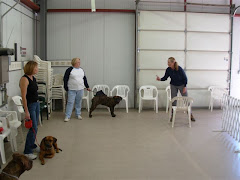Admit it, the first thing you probably taught your dog to do
was sit on command…or on several commands, more likely. Why did you do that???
Seriously, as a good leader there should always be a good
reason for everything you ask your subordinate to do. Nobody likes a leader or employer who dishes
out “busywork” just to keep his minions occupied. Your dog can’t respect you, either, if you’re
constantly badgering him to do meaningless things.
The real reason you immediately taught him to sit was
because it gave you a sense of accomplishment, along with a dose of pride in
your dog who was obviously so smart! (Yes, there is sarcasm there.) It really
doesn’t take much brainwork on the dog’s part to learn how to put his butt on
the floor after you’ve asked him four times in a row.
Many trainers will tell you that you can calm a hyperactive
dog by having him “sit.” To a small
extent, this may be true. However, when
I ask my hyperactive dog to “sit,” I can see her trembling with anticipation of
the release—at which point she’ll burst forth with even more pent-up energy.
Calmness doesn’t come from the position of a butt. It comes from the mind, which is in the
opposite end of the dog (or any other animal).
You may be able to get your dog “still” for a couple seconds by asking
her to sit, but being still is not the
same as being calm. For the mind to
be calm, we must remove the agitations of outside influences, and we must focus
the dog’s energy in one direction: toward us.
The best way to do that is to first develop, practice, and live a
relationship in which your presence
puts the dog at ease. You can accomplish
that, in part, by going back to the Leadership Game when your dog is stressed.
 That said, “sit” is a handy command for your dog to know,
particularly when you start adding the “stay,” which is like glue or Velcro to
the dog’s body position.
That said, “sit” is a handy command for your dog to know,
particularly when you start adding the “stay,” which is like glue or Velcro to
the dog’s body position.
So let’s look at a way we can use “sit” to demonstrate our
leadership capabilities, rather than just as a button we push at our convenience.
Respected leaders are to be taken at their word. They only issue commands one time, and expect
compliance. They expect their
subordinates to be listening to them because they have already earned that
respect. Watch any group of gregarious
animals; the leader of the pack or herd only has to “say” something once
(generally using just body language), and everyone responds. This compliance is key to the survival of the
group! When your dog runs out into the middle of traffic, you may have only one
chance to say “Come” before he’s hit. His life depends on him taking you at your
word.
So why do we say, “Sit.
Sit. Sit” to our dogs? They do NOT have hearing problems! They DO have compliance problems because we
repeat ourselves and fail to physically enforce the commands. So they develop selective hearing and choose
to only sit if they feel like it…or if we bribe them with a cookie.
You can and should teach your dog to sit the FIRST time you
say sit. If you follow through with this
principle in all your commands, you will also teach your dog to COME the first
time you call him out of the busy street.
So from here forward, your dog will sit the very first time
you say it, and you will never have to repeat the command—provided you teach
him the right response from the beginning.
How you teach it:
First decide exactly
where you want your dog to sit. In front
of you? At your side? Wherever he is at the moment? If you want him to sit at your left side
(which we practice in class), get him over there before you ask his butt to go
to the floor.
Next, make sure he’s paying attention. He will not respond if he is looking at (and
thus thinking about) the dog on the other side of the classroom. To get his attention, play Leadership Game
and/or simply say his name. When he
looks up at you, he is ready to listen to you.
With your dog now on your left side facing forward (parallel
to you), place your right hand firmly on your dog’s upper chest. Bring your left hand over to the left side of
his behind. Say “Sit” while pushing up
and back on the chest and down and in on the behind. Keep your hands there for a moment and praise
the dog. “Good sit!” Then release by
standing up and saying “Okay!”
Repeat. You will find the dog
offering less and less resistance to your gentle assist. DO NOT repeat the “sit” command. He heard you the first time. What you are now teaching him is what it
means, and here’s the definition:
“When I say sit, you must immediately lower your butt to the
floor wherever you are at that particular moment. If you do not, my hands will
go on your body and I will place you in the position.”
Rules for using the “sit” command:
- · Don’t ask your dog to do this unless it’s really necessary.
- · Don’t give this command if you can’t physically enforce it after you have said it once.
- · Don’t repeat the command.
- · Make sure your dog is where you want him to end up when you ask him to sit.
- · Always praise.
- · Always release.





















No comments:
Post a Comment